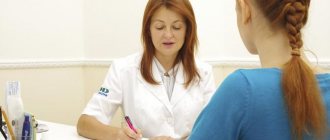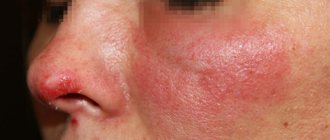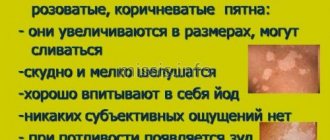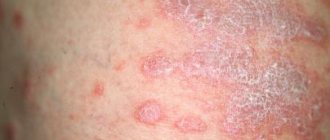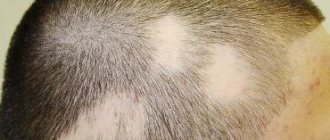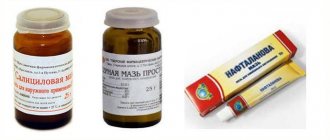Pityriasis versicolor is a fungal infection of the surface layer of the skin. It also has the names “variegated lichen”, “beach lichen”, “sun fungus”, as it is mainly diagnosed in the summer. The disease can be transmitted to other people. It does not pose a threat to life, but it causes aesthetic and physical discomfort and leads to a decrease in the quality of life. Treatment of pityriasis versicolor at home involves the use of ointments, creams and folk remedies. The doctor prescribes medications, and alternative methods are used as auxiliary ones.
Features of the course of the disease
A microscopic fungus that infects the top layer of skin and spreads spores into the mouths of the follicles. Activation of the disease does not occur immediately.
In the absence of favorable conditions, the fungus may not manifest itself in any way for a long time: from 15 days to several months.
At risk are school-age children and young people with reduced immunity, hereditary predisposition and a tendency to hyperhidrosis. Violation of personal hygiene rules, hormonal imbalances and gastrointestinal diseases can also push the onset of the disease to develop. Also, the development of lichen is promoted by foci of chronic infection in the body.
It can be:
- tonsillitis (chronic form);
- caries;
- tuberculosis, etc.
Symptoms of the disease are shown in the photo:
- Peeling of the skin surface.
- Increased sweating.
- The appearance of a specific rash.
- Possible itching.
The spots on the body have uneven edges and different colors. The further the disease develops, the larger the surface of the skin the rash covers. Most often, manifestations of the disease affect the armpits, chest, abdomen, back and sides.
For your information! Most cases of tinea versicolor affect the body, but can also occur on the scalp or nails.
The course of the disease is uneven, alternating between active and fading periods. Most often, the disease begins to develop rapidly in the warm season with high humidity. A cosmetic defect that accompanies a disease causes a person a lot of trouble, disrupting his quality of life and complicating social adaptation.
Pharmacy ointments and creams
Treatment of pityriasis versicolor in humans using ointments/creams can achieve a high effect only if the rules of use are followed and the full course of use of the drugs is completed.
| Name and type of drug described | Composition and therapeutic effect | Rules of use and course | Contraindications and possible negative reactions |
| Fungoterbin (cream) | The active substance (terbinafine) has a destructive effect on the structure of the fungus causing its death. The therapeutic effect lasts up to 24 hours after use. Available without a prescription. | The cream must be applied to the affected area 1-2 times a day for 7 days. | The drug is not used if you are allergic to the components or if the integrity of the skin is damaged. Allergic symptoms are also a negative reaction to the use of the product. |
| Mycozoral (ointment) | The active element of the drug (ketoconazole) has a therapeutic effect similar to Fungoterbin. Sold without a prescription. | The ointment is used once a day for 2-3 weeks. | |
| Ciclopirox (cream) | The main substance (6-cyclohexyl - hydroxy-4-methyl - 2 (1H)-pyridinone) disrupts the metabolic process in the fungus, which leads to its subsequent death. The effect of the composition is observed for 18 hours after application. No prescription required for purchase. | The cream must be applied 2 times a day until the symptoms disappear and then for another 7 days to consolidate the achieved effect. | |
| Sulfuric ointment | The active element (ground sulfur) has a detrimental effect on fungal infections. It also has disinfectant properties. Sold without a prescription. | The ointment is used 2-3 times a day for 5 days. The course of treatment can be extended by a dermatologist. Depends on the dynamics of treatment. | |
| Salicylic ointment | The active substance (salicylic acid) affects the production of sebaceous and sweat glands. As a result, the activity of the fungal infection is disrupted. The antifungal effect is weak. Additionally, the ointment has anti-inflammatory, regenerating and antiseptic effects. Available without a prescription. | The ointment must be applied 2-3 times a day until symptoms disappear. |
Diagnosis and treatment
To select high-quality and effective treatment, the patient must undergo diagnostics. Without an examination, it is difficult to make an accurate diagnosis due to the similarity of symptoms with other diseases.
Diagnostic measures
Diagnostic methods:
- visual examination by a dermatologist;
- biochemical analysis;
- performing the Balser test;
- use of Wood's lamp.
There are the following types of diagnostics:
- Biochemistry. A scraping is taken from the patient. The resulting sample may contain fungal spores when treated with appropriate chemicals.
- Wood's method. The flaky top layer is scraped off. Areas affected by the fungus are detected using a special lamp that produces fluorescent staining. This analysis is carried out in a darkened room.
- Balser's test. An alcohol solution of iodine is used for analysis. It treats the surface of the skin on the diseased area of the body. Upon contact with the fungus, the color produced by iodine becomes more intense.
Remember! After diagnosis, the doctor prescribes appropriate treatment for the patient. It is selected separately for each patient, taking into account the patient’s condition and the duration of the disease.
Safety precautions for self-medication
Home treatment of pityriasis versicolor with folk remedies can lead to severe allergic reactions. To avoid them, be sure to do an allergy test before applying any home remedy to your skin. To do this, the composition is spread on the back of the hand. If after 30 minutes there is no negative reaction, you can use it to treat lichen.
When using aggressive agents (vinegar, lemon, boric acid, sulfur ointment), you must ensure that they do not get on healthy areas of the body and mucous membranes. It is also important that homemade formulations do not fall into the hands of children.
Methods of drug therapy
The main goal of treatment is to eliminate the causative agent of the disease. For this purpose, oral and local antifungal drugs are used. This treatment can be carried out at home.
For your information! If the disease is advanced, treatment will be lengthy.
In order to cope with versicolor, the patient is prescribed a set of measures, including the following medications:
- Selenium preparations, for example, Sulsena.
- Fluconazole or analogue drugs.
- Antimycotic agents.
- Imidazole (Ketaconazole, etc.).
- Ozone therapy.
- Use of products with salicylic acid.
- Enrichment of the diet with vitamins.
In addition to the use of medications, the patient must strictly follow the doctor’s instructions regarding personal hygiene and maintaining a clean home. The duration of treatment in untreated cases is about a week.
How to treat pityriasis versicolor
Home treatment begins immediately after consultation with a dermatologist. In addition to pharmaceutical ointments and anti-lichen tablets, folk remedies are recommended. You need to take care of your skin every day. After treatment procedures, you should lubricate your body with moisturizing creams, use only gentle ingredients in treatment, and use protective agents when sunbathing.
Boric acid
This is a good antiseptic that fights fungus on the skin. It is necessary to treat pityriasis versicolor in humans with boric acid carefully. It has an aggressive effect on the epidermis, but in a short time it relieves the symptoms of the disease.
To prepare the medicinal composition, you will need 10 g of acid powder, which is poured into 200 ml of boiling water. Mix everything thoroughly and insist. After the product has cooled, you need to lubricate the affected areas until completely absorbed twice a day. The course of home treatment lasts a week.
When using boric acid, the positive effect is noticeable within a couple of days.
It is forbidden to resort to this method of treating lichen in case of hypersensitivity, kidney problems, during pregnancy and lactation, if a large area of the body is affected, in children under 1 year of age.
Apple vinegar
Treatment with folk remedies is often based on the use of apple cider vinegar. Thanks to it, the acid-base balance changes and the regulation of electrolyte metabolism occurs. When used correctly, the product is harmless. Use it as follows:
- Skin affected by lichen is treated at least 5 times a day. Before going to bed, apply lotions for at least 10 minutes.
- If the area of the spread of lichen is large, add vinegar to the shower gel (30 ml of vinegar per 250 ml of detergent). This will allow you to cure the disease faster.
- The more often you apply the product to the skin, the faster you can get rid of lichen.
For home treatment, use 3-4% apple cider vinegar, which does not need to be diluted.
The product intended for industrial use must first be diluted with water in a 1:1 ratio. When treating children, vinegar is diluted as follows: 1/5 of a glass of vinegar in half a glass of water. During the procedure, a slight burning sensation is possible. The home therapeutic course continues until complete recovery.
There are no contraindications for external use of apple cider vinegar. Use it with caution to treat children under 10 years of age and for hypersensitivity.
Celandine
The plant has anti-inflammatory, antibacterial, antiviral effects. Excellent fight against fungi, relieves pain and itching.
It is necessary to treat multi-colored lichen with celandine at home carefully, strictly following the instructions, since it is poisonous.
Based on the plant, a homemade decoction and ointment for lichen are made.
- To prepare the decoction, take 2 tbsp. dry chopped herbs, 200 ml hot water. Cook in a water bath for 15-20 minutes. Then cool and filter. The epidermis affected by lichen is treated with a cotton pad soaked in this decoction as often as possible (at least 5 times a day) until the spots disappear.
- For homemade ointment you will need 40-50 g of celandine juice, 30 g of lanolin and petroleum jelly. The resulting mixture is used to treat the affected areas of the body 2-3 times a day. The ointment can also be prepared according to another recipe: melted lard is mixed with celandine juice in equal parts. Stored in the refrigerator. Home treatment lasts until the symptoms of lichen are completely eliminated.
People with chronic pathologies, individual intolerance, the elderly, pregnant and lactating women should use this remedy to treat the disease with caution.
Onion
Onion juice will help cure pityriasis versicolor at home. Pass a medium-sized onion through a meat grinder. Squeeze the juice out of the resulting pulp, which should be used to treat the areas of the body affected by lichen at least three times a day until complete recovery.
Lemon
You can treat pityriasis versicolor at home with lemon juice diluted with water in a 50:50 ratio. The acid contained in the fruit gets rid of fungus. It is also an excellent remedy for preventing disease, especially in the warm season. You can also apply a mixture of grated lemon and garlic to problem areas for an hour.
The citrus product must be used carefully, since lemon is a strong allergen and can lead to irritation, itching, and rashes on the skin.
St. John's wort
Homemade ointment is made from this herb. The dried raw materials are crushed into powder, Vaseline or butter is added. All components are mixed and placed in the refrigerator until solidified. The resulting composition is used to treat the affected areas of the skin three times a day.
A decoction of St. John's wort (2 tablespoons of herb per 200 ml of water), which is also used to wipe the skin, will help get rid of the disease faster.
Home treatment for tinea versicolor with this method lasts 10-14 days or until the body is completely clear of spots.
Sulfuric ointment
The product will help you quickly cure pityriasis versicolor at home. The ointment has an antimicrobial, restorative effect. The body should be dried before application. Salicylic alcohol is good for this. Afterwards, the sulfur ointment is thoroughly rubbed in a circular motion into the affected areas until completely absorbed. It is forbidden to wet the skin the entire day after treatment. It is also important to wear dry underwear and avoid excessive sweating.
The home procedure is carried out once a day, and for advanced lichen - twice. Otherwise, you may get the opposite effect. The course of treatment continues for a week every day without breaks.
Cabbage
To get rid of lichen on the skin, you can use finely chopped white cabbage (3 parts), in combination with bearberry (2 parts) and sea salt (1 part). Mix everything thoroughly and apply to affected areas of the body for 60 minutes. Home treatment lasts 14-21 days. If necessary, the course continues.
Calendula
With the help of this plant, you can not only get rid of ringworm, but also fill the body with flavonoids and carotenoids, which eliminate oily skin. Calendula has a disinfectant and anti-inflammatory effect. There are different methods for treating lichen at home with calendula:
- Tincture. To prepare it you need 2 tbsp. dry crushed flowers pour 100 ml of boiling water. Infuse the composition in a cool, dark place in a glass jar for about a week. Wipe the skin affected by lichen with the resulting infusion once a day.
- Ointment. You will need calendula flowers, hop cones, burdock leaves, taken in equal proportions. Take 2 tablespoons from this mixture, add boiling water, and boil in a water bath for 15 minutes. Strain the broth, mix with petroleum jelly and licorice root, put in the refrigerator to harden (store there). Rub the prepared ointment into the affected skin twice a day.
The duration of home treatment with calendula, regardless of the method, is 14-21 days.
Beet
You can get rid of spots on the skin using beets. The root vegetable is grated on a fine grater. The resulting paste is applied to the skin as a compress for an hour. The dressing should be changed as the beets dry out. Beetroot juice, which is used to treat the affected skin, is also useful.
An adult will get rid of the fungus in 2-3 weeks. Children will need 10-14 days.
Peppermint
This plant has regenerating and antibacterial properties, relieves inflammation, and soothes itchy skin.
Among the various methods of treating lichen at home, mint is used only as an infusion, which is used to lubricate the skin.
Dry crushed herb (1 tbsp) is poured with 200 ml of boiling water, boiled in a water bath for 15-20 minutes, cooled, filtered. The affected areas are smeared with a cotton pad soaked in the broth and left until completely dry. The duration of home treatment is 2-3 weeks.
Sorrel
People with lichen often resort to treatment with sorrel, which not only fights the fungus, but also has a healing effect. There are 2 recipes for home remedies with sorrel:
- A decoction prepared from 1 tbsp. plants in 200 ml of boiling water. Boil for 5 minutes, infuse for 60 minutes, cool, strain. The decoction is used to treat skin with spots.
- Cream with crushed stems and leaves that are mixed with cream. The resulting cream is lubricated on the body.
Treatment should be continued until complete recovery.
Treatment with traditional medicine
The use of traditional medicine methods is possible only after agreement with the attending physician, since otherwise the body may be harmed and recovery will be delayed.
Recipe No. 1. Onion juice
For cooking you will need onions (2 pieces). It should be crushed and the juice squeezed out well. It is recommended to wipe the areas damaged by the disease with the resulting liquid using tampons.
Recipe No. 2. Calendula
One part of calendula flowers must be mixed with five parts of alcohol and left in the dark for 7 days. After this, the tincture is filtered and used to treat the affected areas of the skin.
Acetylsalicylic acid and furatsilin against lichen
Acetylsalicylic acid (regular aspirin tablets) is an excellent remedy against lichen rashes. It is used in this form: crush the tablets into a paste and mix with forty-proof alcohol until smooth, apply to the skin and stick a patch on top. This helps get rid of ringworm in three days.
But the recipe has contraindications - the product should not be applied to rashes in places where there is hair - the mixture can dry them out and make them brittle. It is also not recommended for use on sensitive skin, as it may cause allergic rashes.
Furacilin is an antiseptic exclusively for external use, sold in tablet form in any pharmacy, and costs a penny. Effectively fights pathogenic microorganisms by destroying their cell walls.
To treat lichen, prepare a solution of seven tablets dissolved in 100 ml of water. Use this solution to wipe areas with skin rashes. Immediately after use, when the skin is dry, you can wipe it with a solution of potassium permanganate, this enhances the effect of the treatment procedure.
Causes and characteristic symptoms
Normally, a fungus of the genus Malassezia is constantly present on the body and at the mouth of the hair follicles. However, under the influence of a number of unfavorable factors, it begins to multiply intensively, causing characteristic symptoms. These factors include the following:
- increased sweating;
- failure to comply with basic hygiene rules;
- increased skin oiliness;
- concomitant diseases (diabetes, gastrointestinal pathologies, asthma, hormonal imbalance);
- vegetative-vascular disorders;
- immunodeficiency while taking glucocorticoids or cytostatics.
The first symptom of lichen is small, irregularly shaped spots. They can be localized on the back, sternum, neck, head, legs. They have a pinkish or brownish tint. Peeling in the form of small scales appears on the surface of the spots. There is no inflammatory process, suppuration or pain.
Using effective strokes we “kill” the fungus
If you choose among the many antifungal drugs widely represented on the modern Russian market, then preference should be given to those that, firstly, are able to accumulate in those layers of the skin where the fungal process develops, and secondly, do not penetrate into those layers where fungal activity is impossible. Usually, treatment of lichen versicolor is carried out with local drugs, and in severe cases with the use of systemic antimycotics, which can significantly reduce the treatment time and prevent the frequency of relapses. But you should always remember that if you find signs of a disease in yourself, under no circumstances try to treat yourself, but immediately go to a doctor who will accurately determine your diagnosis and prescribe the right treatment for you.
Celandine
If tinea versicolor is diagnosed, treatment with folk remedies can be carried out using celandine. To prepare the tincture you will need leaves, stems and flowers of celandine. It is better to collect it away from roads and city limits.
Grind the collected ingredients and mix with sugar in a ratio of 1/1 (to prepare one serving you will need 200 grams of celandine). The resulting pulp must be wrapped in gauze in a bag. Then you take yogurt or cottage cheese, pour it into a two-three-liter jar, into which the prepared bag of crushed celandine is placed.
The resulting composition should infuse for a month at room temperature. When a film appears in the jar, it must be removed, and if the bag begins to float, then it must be pressed down with something. After a month of infusion, the resulting essence must be filtered and stored in the refrigerator.
You can take the tincture 3 times a day, one tablespoon after meals. If during or after taking there is discomfort in the stomach, dizziness or nausea, then the dose must be reduced.
Effective ointment for lichen
Ringworm is a dermatological disease that occurs in both adults and children. To eliminate it, various drugs are used, both in release form and in effectiveness.
Let's look at the top 10 effective ointments for lichen:
- Preparations based on sulfur, tar, zinc and salicylic acid have no contraindications and do not cause adverse reactions. They have antiseptic, disinfectant, anti-inflammatory and antifungal properties. Suitable for treating children and pregnant women.
- Miconazole is a broad-spectrum antifungal agent. Effectively copes with the treatment of pityriasis versicolor. The active substance destroys the causative agent of the disease and accelerates the restoration of damaged tissues.
- Zovirax, Herperax, Acigerpin are antiherpetic drugs with the active ingredient acyclovir. Effective in the treatment of herpes zoster.
- Exoderil - most often prescribed for ringworm. Contains the active component - naftifine, has anti-inflammatory properties and destroys parasitic fungi.
- Hydrocortisone is a corticosteroid with antihistamine properties. Eliminates itching, pain and burning, but has a number of side effects, so it is used only for medical prescription.
- Clotrimazole - prescribed for color, red flat and ringworm. Active against a wide range of viruses and fungi. It is used until the disease is completely eliminated.
- Nizoral - quickly and effectively fights sunburn, eczema, dermatitis and other skin diseases. Contains the active ingredient – ketoconazole.
- Mycoseptin is an antifungal agent that contains zinc undecylenate and undecylenic acid. Soothes damaged skin, relieves inflammation, irritation, and disinfects. Helps with ringworm.
- Terbinafine - treats versicolor and herpes zoster, various dermatitis, eczema. It can cause a number of adverse reactions, so it is used as prescribed by a doctor.
- Flucinar and Sinalar are hormonal drugs. Used for lichen planus and rosea, psoriasis, eczema, dermatitis of various etiologies. Quickly eliminate itching, burning and other painful symptoms.
Any effective ointment for lichen must be prescribed by your doctor. This is because some drugs are effective against one form of shingles but not others. Self-use of medications is dangerous, as it can cause uncontrollable side reactions, aggravating the course of the disease.
Independence, which can get in the way
As mentioned above, there are many types of lichen, so you should not try to treat strange spots or rashes that suddenly appear on you. Since the symptoms of some types of lichen are similar to the symptoms of other diseases, consult a dermatologist so that in the process of self-medication you do not trigger the true disease and harm yourself even more. Each type of lichen has its own specific treatment. Some can be cured with special antiviral or antifungal ointments, others require a course of immune restoration, and some even go away on their own. Therefore, if you have lichen, follow only the advice of a dermatologist, and do not try to treat yourself.

